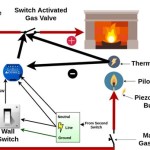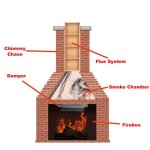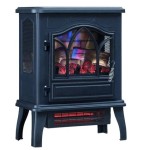Cleaning Your Fireplace with Muriatic Acid: A Comprehensive Guide
Muriatic acid, also known as hydrochloric acid, is a potent chemical compound widely used for various cleaning and industrial applications. While effective in removing stubborn stains and mineral deposits, its use requires caution and a thorough understanding of the potential risks. Applying muriatic acid to clean a fireplace, particularly the brick or stone surrounding it, can be an efficient method for removing soot, creosote, and other accumulated debris. However, improper handling or application can lead to damage to the fireplace, personal injury, or environmental contamination. This article provides a detailed guide on how to safely and effectively clean a fireplace using muriatic acid, emphasizing safety precautions and proper procedures.
Before embarking on any cleaning project involving muriatic acid, it is crucial to assess the fireplace's condition and the type of materials it is constructed from. Certain materials, such as polished marble or some types of soft brick, may be more susceptible to damage from the acid. A small, inconspicuous test area should always be treated first to observe the acid's effect on the surface. If discoloration, etching, or other signs of damage occur, alternative cleaning methods should be considered. Furthermore, ensure the fireplace is thoroughly cooled and that no embers or hot ash remain before beginning the cleaning process. Safety equipment, including appropriate protective gear, is non-negotiable.
Safety First: Essential Protective Measures
Muriatic acid is highly corrosive and can cause severe burns upon contact with skin or eyes. Inhalation of its fumes can also lead to respiratory irritation. Therefore, comprehensive personal protective equipment (PPE) is mandatory. This includes acid-resistant gloves, such as those made of nitrile or neoprene, to protect the hands. Eye protection is equally critical; safety glasses or goggles with side shields should be worn to prevent splashes from entering the eyes. Additionally, a NIOSH-approved respirator is recommended to filter out harmful fumes, particularly in enclosed or poorly ventilated spaces. Long sleeves and pants provide further protection against accidental splashes. The work area should be well-ventilated, ideally with open windows and doors to allow for adequate air circulation. If adequate ventilation is not possible, a forced-air exhaust fan can be used to draw fumes away from the user.
Furthermore, it is vital to have a readily available source of clean water in case of accidental acid exposure. A garden hose or a large bucket of water should be nearby for immediate rinsing. If acid comes into contact with the skin, flush the affected area with copious amounts of water for at least 15 minutes. For eye exposure, flush the eyes with water for at least 20 minutes, holding the eyelids open to ensure thorough rinsing. In either case, seek immediate medical attention after rinsing. It is also advisable to inform someone about the intention to use muriatic acid, and to have them nearby or regularly checking in, in case assistance is needed.
Neutralizing agents, such as baking soda or lime, should also be readily available. These can be used to neutralize any spilled acid and to prevent further corrosion or damage. Mixing muriatic acid with other cleaning agents, particularly those containing ammonia or bleach, is extremely dangerous and can produce toxic gases. Only mix muriatic acid according to the manufacturer's instructions and with water only.
Preparation and Dilution: Achieving the Right Concentration
The effectiveness of muriatic acid in cleaning a fireplace relies heavily on proper dilution. Using the acid in its concentrated form is rarely necessary and significantly increases the risk of damage and injury. The recommended dilution ratio typically ranges from 1 part muriatic acid to 5 to 10 parts water. Always add the acid to the water, never the other way around. Adding water to concentrated acid can cause a violent reaction, potentially resulting in splashes and burns. Using a plastic container specifically designated for chemical mixing is recommended. Do not use metal containers as the acid can react with the metal.
Before applying the diluted acid solution, thoroughly clean the fireplace with a brush and water to remove loose debris, ash, and soot. This will allow the acid to more effectively penetrate and dissolve the remaining stains. Protect surrounding surfaces, such as flooring or furniture, with plastic sheeting or drop cloths. Masking tape can be used to define the areas to be treated and prevent the acid from spreading to unintended surfaces. Consider applying a pre-wetting solution of water to the brick or stone before applying the acid mixture. This can help to prevent the acid from being absorbed too quickly, which can lead to uneven cleaning or damage.
A test spot is once again crucial at this stage, even with the diluted solution. Apply the diluted acid to a small, inconspicuous area and observe the reaction. Check for any discoloration, etching, or other signs of damage. If the solution appears to be too strong, further dilute it with water. The goal is to find the weakest concentration that effectively cleans the fireplace without causing any harm to the material.
Application and Rinsing: The Cleaning Process
Once the diluted acid solution is prepared and the surrounding areas are protected, the application process can begin. Use a stiff-bristled brush or a pump sprayer to apply the solution to the fireplace surfaces. Avoid using a high-pressure sprayer, as this can cause the acid to atomize and spread the fumes. Apply the solution evenly, working in small sections at a time. Allow the acid to dwell on the surface for a few minutes, but no more than 10-15 minutes, depending on the severity of the stains and the material being cleaned. Agitation with a brush during the dwell time can help to loosen stubborn deposits.
After the dwell time, thoroughly rinse the treated area with clean water. Use a garden hose or a bucket of water and a brush to ensure that all traces of the acid are removed. Multiple rinses may be necessary to completely neutralize the acid. A pH testing kit can be used to confirm that the surface is neutral (pH 7) after rinsing. If the pH is still acidic, continue rinsing until a neutral pH is achieved.
For heavily soiled areas, a second application of the diluted acid solution may be necessary. However, it is generally better to use multiple applications with a weaker concentration rather than a single application with a stronger concentration. This minimizes the risk of damage to the fireplace. After the final rinse, allow the fireplace to air dry completely. Inspect the cleaned surface for any remaining stains or damage. If necessary, repeat the cleaning process or consider alternative cleaning methods for any remaining stubborn stains.
Proper disposal of the used muriatic acid solution is essential for environmental safety. Never pour the acid down the drain or into the ground, as it can contaminate water sources. Neutralize the acid solution by adding baking soda or lime until the pH reaches a neutral level (pH 7). Once neutralized, the solution can be disposed of according to local regulations. Contact the local waste management authority for specific guidelines on the disposal of neutralized acid solutions.
In conclusion, while muriatic acid can be an effective cleaning agent for fireplaces, its use demands meticulous planning, strict adherence to safety protocols, and a thorough understanding of the materials being cleaned. Neglecting these aspects can result in serious injury, property damage, or environmental harm. If uncertainty exists regarding the suitability of muriatic acid for a particular fireplace material or the proper application techniques, professional cleaning services should be consulted.

Brick Mortar Cleaner Chimneysaver

How To Clean Fireplace Bricks 9 Steps With S Wikihow

Vane Cottage Chemical Brick Mortar Soot Cleaner 6

Safer Brick And Masonry Cleaner

How To Clean Brick With Acid Ask This Old House

How To Clean Brick The Home Depot

How To Clean Up Blackened Stone Fireplace Page 1 Homes Gardens And Diy Pistonheads

Klean Strip Green Muriatic Acid Masonry Cleaner 1 Gal At Tractor Supply Co

How To Clean Quartz Rock Fireplace Hometalk

How To Clean Quartz Rock Fireplace Hometalk
Related Posts








